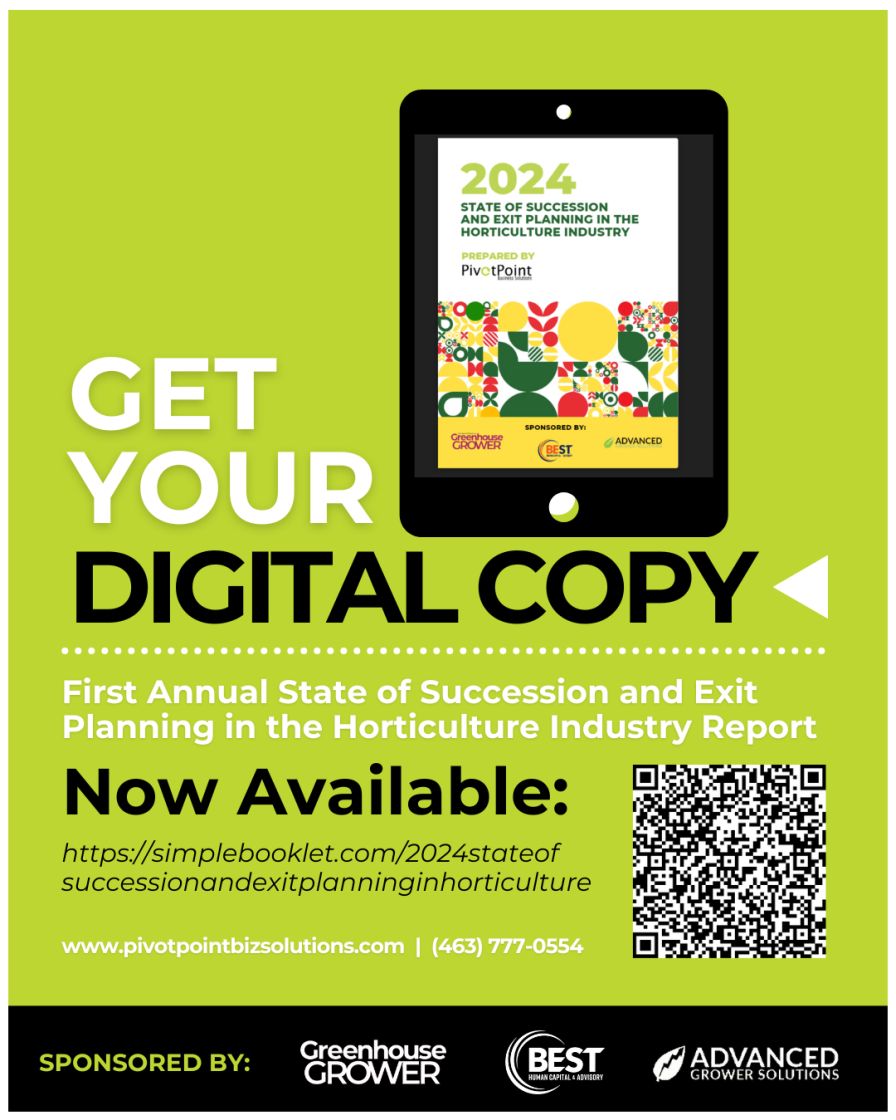
First annual “State of Succession and Exit Planning in the Horticulture Industry” survey report | Greenhouse Grower
According to the Small Business Administration, 10 million Baby Boomer-owned businesses will change hands or shut down in the next decade due to a lack of buyers. Even when there is a willing buyer, the Exit Planning Institute estimates that 80% of businesses are unprepared for sale, leaving buyers uncomfortable closing the deal. Worst of all, 75% of business owners who do sell profoundly regret their decision one year later if they have not properly planned for that momentous life event.
PivotPoint Business Solutions, in collaboration with Greenhouse Grower, BEST Human Capital and Advisory Group, and Advanced Grower Solutions, conducted the first-ever “State of Succession and Exit Planning in the Horticulture Industry” survey, and unveiled its findings at Cultivate’24. This survey provides a comprehensive look at how horticulture business owners are preparing for their eventual exits, addressing previously underexplored areas, and offering valuable insights into business attractiveness, owner financial preparedness, and owner readiness.
The survey identified 10 key themes that, if implemented, can prepare the business for transition and make the business highly desirable to potential buyers generating the highest return for the owner.
1. Have an Exit Plan
Survey respondents who do not have an exit plan totaled 32%. Among those who want to exit within two years, 55% have yet to start planning. Early planning is crucial, as it takes three to five years to build and execute an exit plan to maximize value and return. This allows for a structured and thoughtful approach, reducing the risk of last-minute decisions that could negatively impact business value. Being prepared at all times also prepares owners for the positive outcome of an unsolicited offer from a third-party buyer and the not-so-positive outcome of forced exit due to death, disability, divorce, disagreement between owners, or business distress.
2. Exit Planning Is a Team Sport
Only 33% of our respondents are working with advisors to prepare for their exit. While, as the owner, you are the center of the exit plan, the endeavor is so varied that you cannot manage it on your own. Exit planning requires diverse perspectives from multiple stakeholders and specialists, including external trusted advisors, management, and family members. You need a team to provide expertise in different areas crucial to your exit, help manage the process, and ensure a smooth transition.
3. Communication is Key
For survey respondents who plan to exit in less than two years, 80% have shared at least part of their plan with their management team. Regularly discussing plans with key stakeholders including family members, employees, and potential successors, ensures everyone is on the same page, prevents misunderstandings, and keeps everyone aligned with the business goals and transition timeline. Intentional communication about your eventual exit will also allay employee fears and mitigate defections when the time does come.
4. Prioritize Personal Financial Readiness
Many business owners are facing financial uncertainty, with respondents rating their financial readiness a 58 out of 100. Additionally, nearly 70% of owners are unsure of their after-tax, post-transition income needs and haven’t conducted a formal business valuation. Knowing what your business is worth, and your post-sale financial needs, is essential for creating a solid financial future. We consider 80 out of 100 the beginning of the range for success in your personal financial plan. If you’re below that level, a financial planner needs to be added to your team of advisors. Financial readiness involves understanding your personal financial goals, assessing your retirement needs, and ensuring you have adequate resources to support your desired lifestyle after the business transition.
5. Your Spouse Is Not Your Trusted Exit Advisor
When asked, “Who is your most trusted advisor?” most survey respondents let us know it is their spouse. That’s wonderful in life, if for no other reason than for domestic tranquility! However, specialists outside the family need to guide the exit planning process. Key advisors include an exit planner, personal financial planner, CPA, and business attorney. These professionals provide a holistic perspective that leads to the best outcome. External advisors can offer objective insights and ensure that all aspects of the transition, including legal, financial, and operational considerations, are thoroughly addressed.
6. It’s All in the Name
For 34% of our respondents, the family name is part of their business name, but 76% do not have a family interested in taking over the business. Our industry has a far larger percentage of multi-generation owners than average. This contributes to the reputation for which horticulture operations have come to be known — hard-working, proud owners, and great businesses where employees are treated like family. A gradual transition to a new company name years ahead of the anticipated transaction can help make the business more attractive to external buyers by reducing perceived dependencies on the family identity.
7. The Customer Is King
Only 7% of respondents do a written client satisfaction survey. Incidentally, most owners tell us their customers love them and come back year after year. We believe you! Potential buyers, however, will want evidence of client satisfaction. Using low-cost subscription services featuring the Net Promoter Score can meet potential buyers’ expectations. Regularly gathering and analyzing customer feedback helps demonstrate to potential buyers that the business has a strong and loyal customer base. This can be a critical factor in negotiations and valuation.
8. Survival of the Fittest
Roughly 65% of survey respondents told us they haven’t taken a two-week vacation in more than two years, and 43% have never taken a two-week vacation! Time away is necessary to recharge your batteries and build confidence in your team. If your team can’t manage the day-to-day without you, and the business suffers when you’re gone, a potential buyer may decrease their offer. So, take a vacation, and do it often. Assessing operations during that time lets you perfect your human capital strategy so your team can execute flawlessly in your absence.
9. The Balancing Act
Only 15% of respondents consider their technology and systems leading edge. While tech solutions may take a back seat to growing and selling great plants, investments that lead to increased gross margins are worthwhile. If a technology investment leads to a higher margin payback in five years, do it! Consider scaling back on investments within three years of transition to maintain consistent margins valued by buyers. Implementing efficient systems and technologies can improve productivity, reduce costs, and enhance overall business performance. This can make the business more attractive to buyers looking for streamlined operations.
10. Business Readiness Is Critical
Respondents rated their business exit readiness a 3 out of 10, with none rating higher than 6. Businesses that sell at their desired price average 8 out of 10 in readiness. Those that sell at a discount average 5 out of 10, while businesses that don’t sell average below 5. If you do one thing this year, focus on business readiness for a successful exit when the time is right!
What Did We Learn?
The state of succession and exit planning in the horticulture industry is mixed. Many owners remain reluctant to discuss the “end game” when it comes to their business. They are so focused on day-to-day operations that they can’t step back and think about the future. Or, they simply don’t want to talk about leaving the business they’ve spent many years of their life building. As a result, they may fall into the owner’s trap where owner-centricity becomes a mainstay and potentially a significant hazard to a successful transition. After all, if the owner is the business, what’s left to transfer after the owner is gone?
Nobody knows if recent industry consolidation will continue, but we certainly want to reverse the trend of operations shutting down without the owners realizing the sale value from years of hard work. So, preparation needs to be the priority. By focusing on early planning, seeking professional advice, improving communication, and ensuring team readiness, horticulture business owners can better prepare for transition at any time.
A well-thought-out exit strategy not only benefits the individual owner, their employees, and customers, but also contributes to the long-term stability and growth of the horticulture industry at large.

